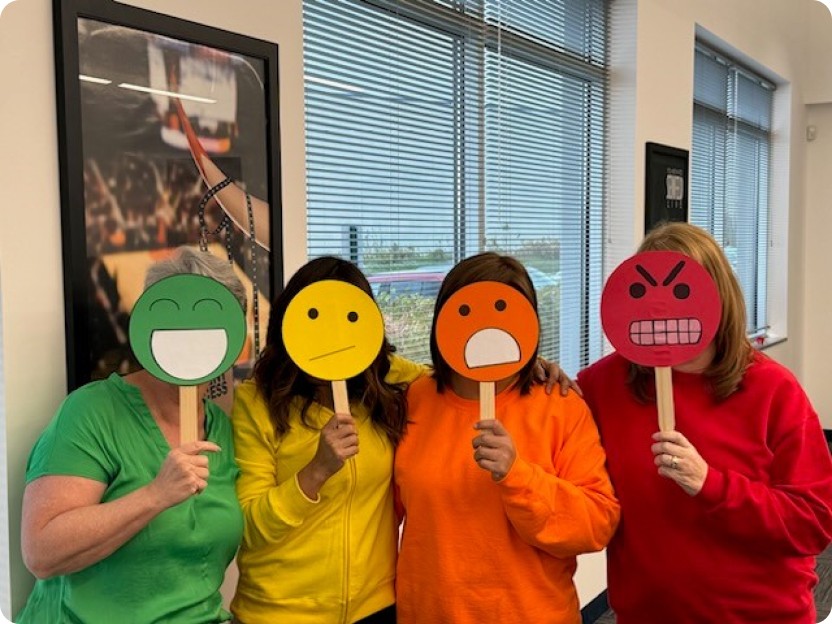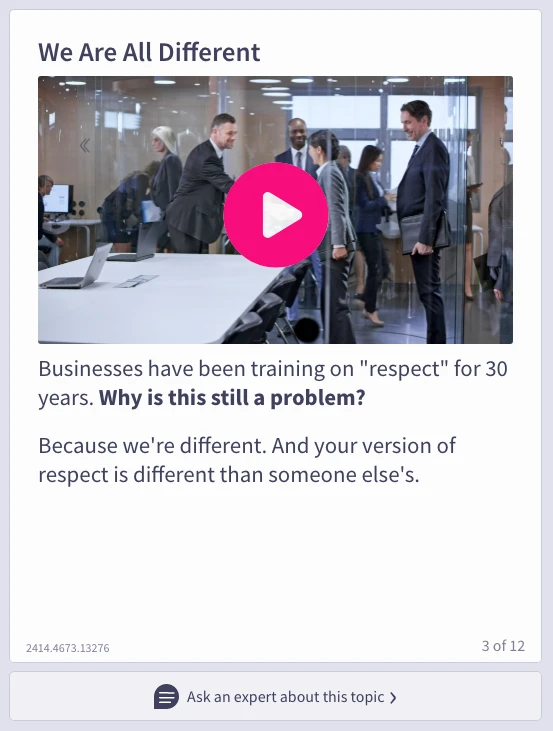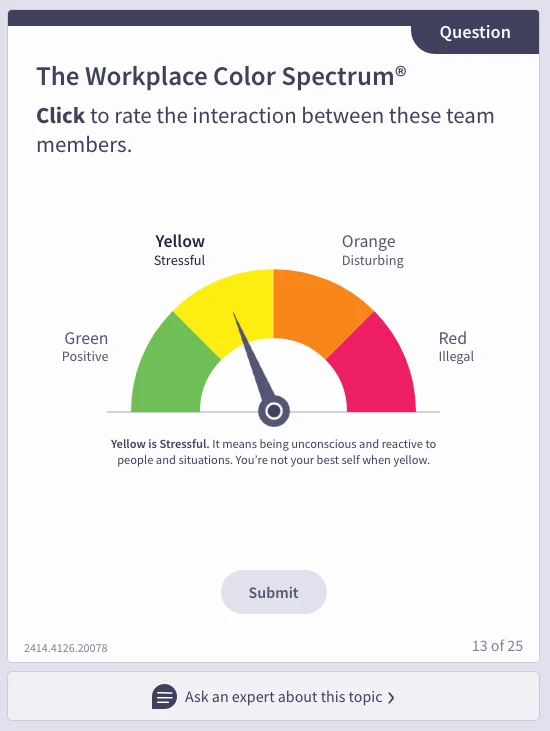Discover how the Workplace Color Spectrum® helps organizations address harassment complaints and reduce employee relations claims by identifying and improving workplace behaviors. From respectful (Green) to toxic and illegal (Red), this proven framework helps teams to communicate effectively, resolve workplace conflicts, and foster a positive, inclusive workplace culture.
Take our Workplace Culture Quiz to find out how your workplace stands and get a FREE Infographic to use in your workplace to identify behaviors. You’ll also receive an assessment of your quiz results, and a badge to share with your colleagues.
In this video, learn what the Workplace Color Spectrum is, and how this communication tool is used to identify workplace conduct.
Used by thousands of organizations since 2013, Emtrain’s exclusive Workplace Color Spectrum® is an easy behavior rating tool to help you and your colleagues communicate more effectively about issues in your work culture.
Have you ever heard someone use the term “harassment” incorrectly to mean anything they believe is unfair or bad? How do people react when accused of being a harasser?
Using the Workplace Color Spectrum can reduce emotional responses — and create positive behavioral change.
Green means being socially aware and respectful. You consciously shift your perspective to consider others. You bring your best self to work when your behavior is green.
Yellow means you act before you think. You’re reactive to people and situations, and not conscious of the way your behavior is impacting others. You’re not your best self when your behavior is yellow.
Orange means you say things related to other people’s legally protected characteristics (race, sex, religion, age, etc.), with negative impacts. You’re contributing to a disrespectful workplace when your behavior is orange.
Red means that the Orange behavior happens frequently, negatively affecting and making the workplace toxic. Red conduct is illegal.
Distinguishing harassment from inappropriate behavior isn’t always clear. Emtrain’s Employee Complaint Decision Tree, powered by the Workplace Color Spectrum®, helps both HR teams and employees characterize harassment or bad behavior with a few simple questions.
Our clients incorporate the Workplace Color Spectrum® into their every day work lives. We hear great stories, like when a CEO stopped an inappropriate story being told at a group lunch by saying “that’s getting a little orange,” or how HR teams have adopted the Workplace Color Spectrum® to help explain to people why certain behaviors aren’t acceptable in their organization.
One of the things that the Workplace Color Spectrum® brings to light is that people have different perspectives: one person might think an action is Green and another might say it’s Orange. With five generations in the workplace and increasing diversity of race and nationality, it’s bound to happen. The whole point is to help colleagues address what feels uncomfortable, stop and apologize, and go forward on common ground.
“At Computacenter, we are dedicated to fostering a positive work environment where people can be themselves. Our people are our most valuable assets, and we are committed to providing a safe space for them to thrive. The Workplace Color Spectrum used in the Preventing Harassment Training has been a beneficial guide. Employees find it easy to use and effective for communicating workplace behaviors simply by referring to a color that defines the behavior.”
Wendy Coticchia
SVP Head of Compliance
the Americas & APAC
Computacenter

The Workplace Color Spectrum® is a big part of how we help grow awareness and empathy — and nudge behavior change — in the workplace. Emtrain’s interactive tool engages employees to help them think and see if they’re an outlier and teaches them the impact of behaviors. It also helps us teach laws and regulations.

Emtrain’s video content is a cornerstone of our learning experience. We provide learners with relevant, thought provoking workplace scenarios depicting some of the most common culture issues facing organizations today. Our video content has been recognized by the New York Times, Vice News, and Entrepreneur Magazine.

Workplace culture issues are never black and white, and neither is our content. Our nuanced workplace videos serve to illustrate the course messaging, and provide context for the Workplace Color Spectrum®. Fixing workplace culture means having tough conversations, this is the content that starts the conversation.

Our Workplace Color Spectrum® is not just a common language used to identify bad behavior. It is an analytical tool embedded in all of our courses that allows us to gather learner sentiment about certain culture issues, then deliver that data to you in a digestible format so you can spend less time diagnosing culture, and more time fixing it.
Emtrain’s Preventing Workplace Harassment online training teaches much more than the laws and regulations. We explore your workplace culture, through the eyes of employees, to understand how prevalent bad behaviors might be, and if they feel comfortable addressing them in a healthy feedback cycle. Our Workplace Culture Report 2025 found that there’s still a lot of work for organizations to do to create healthy workplace cultures. Contact us to see how we can help.
of employees say that if someone does something inappropriate in the workplace, people will let them know
of employees agree that their co-workers understand the impact their words and behaviors have on those around them
of employees have to minimize part of their heritage and/or personal identity in order to fit into a job
The Workplace Color Spectrum® is an easy-to-use behavior rating tool that helps employees and organizations communicate effectively about workplace issues. It categorizes behaviors into four colors: Green (respectful and socially aware), Yellow (reactive), Orange (disrespectful comments tied to protected characteristics), and Red (toxic and illegal behaviors). By identifying behaviors objectively, the tool reduces emotional responses and enables positive cultural change.
The Workplace Color Spectrum® provides a shared language for employees to address workplace behaviors without making personal accusations. By focusing on conduct, not individuals, it helps de-escalate conflicts, improve communication, and promote collaboration. Teams can quickly identify inappropriate behavior (e.g., Yellow or Orange) and address it before it escalates into toxic (Red) conflict.
Employees can evaluate their behavior on the four-color spectrum:
By understanding where their actions fall, employees can reflect, improve, and contribute to a healthier workplace culture.
Disrespectful behavior, such as Yellow or Orange conduct, may seem minor at first but can quickly escalate into toxic (Red) behavior if left unchecked. Over time, small incidents demotivate teams, damage morale, and create a hostile workplace culture. Addressing behaviors early fosters trust, encourages collaboration, and prevents legal and organizational consequences.
The Workplace Color Spectrum® is integrated into Emtrain’s compliance training programs and culture-building tools. These programs teach employees how to recognize and address workplace behaviors effectively, promote respectful communication, and reduce harassment and conflict. Emtrain’s online training helps organizations create healthier, inclusive workplace cultures by using real-world examples and actionable strategies.
My co-workers are respectful to others regardless of their race, age, gender identity, sexual orientation, or job title.
I see conflict arise between co-workers because of different social and political views.
My manager models and reinforces respectful norms of behavior.
My skills and efforts are valued fairly at my organization.
Q